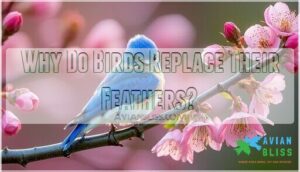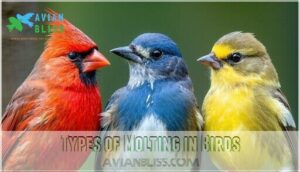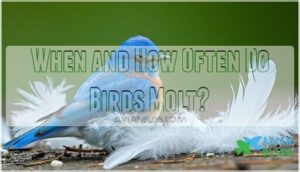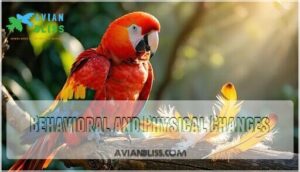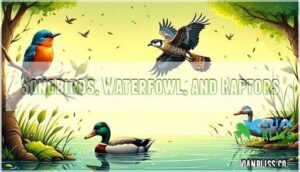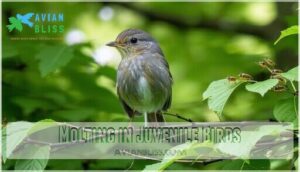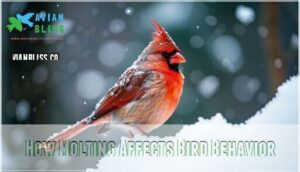This site is supported by our readers. We may earn a commission, at no cost to you, if you purchase through links.
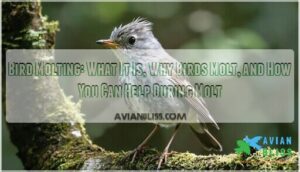 Bird molting is nature’s way of giving birds a fresh start, swapping out tired, worn feathers for new ones that keep them flying high and looking sharp. You’ll notice your feathered friends losing patches of old plumage, sprouting pin feathers, and maybe acting a bit quieter than usual.
Bird molting is nature’s way of giving birds a fresh start, swapping out tired, worn feathers for new ones that keep them flying high and looking sharp. You’ll notice your feathered friends losing patches of old plumage, sprouting pin feathers, and maybe acting a bit quieter than usual.
Molting boosts flight, insulation, and even those fancy breeding displays. It’s a structured process, kind of like changing into a new outfit for the season. If you spot a bird looking scruffy, don’t worry—it’s just embracing a bit of wild freedom.
Curious about how you can help birds through molting? There’s more to uncover.
Table Of Contents
- Key Takeaways
- What is Bird Molting?
- Why Do Birds Replace Their Feathers?
- Types of Molting in Birds
- When and How Often Do Birds Molt?
- Signs and Stages of The Molting Process
- Unique Molting Patterns Across Bird Species
- How Molting Affects Bird Behavior
- Supporting Wild and Pet Birds During Molt
- Common Challenges and Molting Care Tips
- Frequently Asked Questions (FAQs)
- How long does bird molting last?
- During which month do most birds molt?
- How do you help a molting bird?
- What do birds look like when they molt?
- Do all birds molt at the same time of year?
- Why do birds molt in secluded areas?
- Do all birds molt the same amount of times per year?
- How do birds behaviours change when they molt?
- What do moulting patterns look like in wild birds?
- Can molting affect a bird’s lifespan?
- Conclusion
Key Takeaways
- You’ll see birds lose old feathers and grow new ones during molting, which keeps their plumage strong for flight, insulation, and protection.
- Molting follows a structured cycle, not random shedding, and timing depends on species, age, and environment.
- Birds need extra protein, fresh water, and a stress-free space to support healthy feather regrowth while molting.
- You’ll notice behavioral changes like less activity and quieter vocalizations, as birds conserve energy and stay safe during this vulnerable period.
What is Bird Molting?
When you see birds looking a bit scruffy, they’re probably molting, which means they’re shedding old feathers and growing new ones to stay healthy. This natural process helps birds maintain strong plumage for flight, insulation, and protection from the environment.
Definition and Key Concepts
Understanding bird molting means knowing it’s a structured process where birds swap old feathers for new ones. Feather replacement happens in stages, with each molt cycle bringing fresh plumage.
Basic plumage is the bird’s standard feather coat, adapted for survival. Molting stages help birds maintain insulation and protection, keeping them ready to soar through changing seasons.
Difference From Shedding
Bird molting isn’t just shedding feathers like a dog losing fur. Molt is a structured process, not random. Shedding is unplanned, while molting follows a predictable cycle for complete renewal. Feathers aren’t living tissue—they’re made of keratin, so they can’t heal, only be replaced.
Here’s how molting stands apart:
- Structured Process
- Keratin Replacement
- Predictable Cycle
- Complete Renewal
- Not Living Tissue
Importance for Bird Health
When you look past shedding, you’ll see how the molting process is essential for feather quality and overall health. Molting birds replace feathers to boost flight performance, conserve energy, and maintain thermoregulation. High protein foods support immune function and help grow strong feathers.
Here’s how molting impacts health:
| Feather Quality | Energy Expenditure | Immune Function |
|---|---|---|
| Insulation | Efficient flight | Protection |
| Waterproofing | Less fatigue | Disease defense |
| Camouflage | Better movement | Faster healing |
| Strong growth | Survival | Stress relief |
Why Do Birds Replace Their Feathers?
You might notice birds looking a bit scruffy at certain times of the year, but replacing their feathers is essential for staying strong and healthy.
Birds shed old, worn feathers to keep flying efficiently, stay warm and dry, and even change their appearance for camouflage or attracting a mate.
Feather Wear and Tear
Each day, feathers face a barrage of challenges—sun, wind, and rain all play a part in Feather Degradation and fading. Environmental factors like dust or branches cause Keratin Damage, making feathers fray and lose color.
As wear sets in, Preening Effectiveness drops, so birds must replace feathers regularly to keep their plumage healthy and looking sharp.
Maintaining Flight Efficiency
After constant use, flight feathers can get battered and lose their edge, much like worn tires. When old feathers break down, your bird’s flight performance drops, and energy expenditure soars.
Molting birds synchronize feather replacement to keep their Feather Aerodynamics in top shape. Good feather quality means smooth flying, less drag, and better flight efficiency out in the wild.
Insulation and Waterproofing
Once worn feathers lose their punch, it’s not just about flight. Effective insulation is at stake. The right feather structure keeps warmth close on chilly nights and shields waterbirds from getting soggy. Preening, fueled by the oil gland, helps waterproof plumage. Molting lets birds swap shabby feathers for fresh ones.
Here’s why this matters:
- Maintains thermal regulation in cold weather
- Keeps plumage water-resistant
- Enhances aquatic adaptations in swimmers
- Allows replacement of worn feathers
- Boosts overall feather health
Camouflage and Breeding Displays
During molting, birds swap out their old basic plumage for fresh feathers, often revealing stunning breeding plumage or subtle camouflage. Molt camouflage helps many species blend into the background, while alternate plumage facilitates flashy seasonal displays. These bird plumage changes boost mate attraction but also keep feather quality high—think sharp suits for dates, and duller clothes for sneaking by predators.
Types of Molting in Birds
You’ll notice that birds don’t all molt the same way; some shed all their feathers at once, while others change just a few at a time. Understanding the differences between complete and partial molts, as well as changes in plumage and molting patterns, helps you spot what your local birds are up to each season.
Complete Vs. Partial Molt
As birds replace worn feathers, you’ll see two main approaches: complete molt swaps out every feather, while a partial molt only targets a specific area or plumage type. Here’s what sets them apart:
- Feather Replacement Extent—full vs. patchwork
- Energy Expenditure—higher during a complete molt
- Molt Sequence—fixed order keeps birds flying and safe
Basic and Alternate Plumage
After exploring how a bird can have a full or partial feather change, it’s time to untangle the fuzz around basic and alternate plumage. Birds sport basic plumage most of the year, while alternate, or breeding plumage, comes out for courtship.
This shift in feathers—called the molt sequence—lets birds show off vibrant colors or stay hidden with cryptic plumage.
Juvenile Vs. Adult Molting
After learning about basic and alternate plumage, it’s good to know that not all molts are the same. As a bird moves from juvenile stages to adulthood, you’ll notice:
- Plumage differences between juvenile and adult birds
- Molt timing can shift with age
- Energy expenditure increases during the molt cycle
- Vulnerability window widens, demanding careful attention to nutritional needs
When and How Often Do Birds Molt?
You’ll notice that birds shed and replace their feathers at specific times, depending on their species and environment. Most birds go through one or more molts each year, following a schedule that keeps their plumage healthy and ready for flight.
Seasonal and Annual Molting Cycles
After understanding complete versus partial molting, it helps to know that molt frequency syncs with nature’s rhythm. Many birds begin a new molting cycle after breeding. Changes in daylight, food, and weather kick-start shedding, shaping basic and alternate plumage.
Migration impact and environmental factors also set the pace, creating molt cycles that are as predictable as the seasons themselves.
Species-Specific Molting Patterns
Now and then, you’ll spot a Songbird Molt happening in midsummer, with feathers replaced in a steady sequence, while Waterfowl Molt often leaves ducks flightless for weeks. Raptor Molt often happens in slow, symmetrical waves, and Seabird Molt can stretch over years.
Juvenile Molt is rapid, with each species following its unique molting patterns—much like a HumphreyParkes roadmap.
Factors Influencing Molt Timing
Timing is everything in the context of a bird’s molt. You’ll notice that several things shape when birds swap those feathers:
- Food Availability during molting season
- Climate Change affecting molt patterns
- Predation Risk and a need for cover
- Hormonal Cycles connected to breeding season
- Geographic Location impacting migration or nonbreeding periods
During this time, adequate protein intake is essential for feather regrowth.
Signs and Stages of The Molting Process
You’ll notice molting birds lose old feathers in patches, while new pin feathers start to grow in their place.
As you look more closely, you may see changes in behavior and appearance that signal each stage of this important process.
Visible Feather Loss
You’ll spot visible feather loss as birds begin their molt journey. Patchy plumage, bald spots, or a noticeable drop in feather quantity often signal molting. Don’t worry—this isn’t a bad hair day, just part of nature’s cycle. A disruption in their system can cause abnormal feather loss.
Use the table below to compare what you might notice:
| Sign | Area |
|---|---|
| Bald Spots | Head, Neck |
| Patchy Plumage | Wings, Back |
| Fewer Feathers | Tail, Chest |
| Molt Intensity | Whole Body |
Pin Feathers and Feather Growth
As feathers drop, you’ll notice new ones poking through—the famous pin feathers. These little tubes are packed with keratin, fueling rapid feather development. At the blood feather stage, they’re sensitive, so gentle pin feather care is key. Watch for any abnormal feather growth as your bird’s feather development timeline unfolds.
- Keep handling gentle
- Offer protein-rich food
- Monitor for damage
Behavioral and Physical Changes
Keep an eye out for subtle changes as your bird molts. You’ll notice decreased vocalization, reduced activity, and some behavioral adaptations, like seeking hidden spots.
Molting is a physically demanding process, with energy expenditure going into plumage changes. Some birds even show a clear molt-migration link, leaving early or late.
Care during these shifts aids your molting bird’s comfort.
Unique Molting Patterns Across Bird Species
You’ll notice that different bird species have their own unique molting schedules and patterns, with some changing feathers quickly and others taking their time.
Understanding these differences helps you spot normal molting behavior in songbirds, waterfowl, and raptors, as well as in young birds growing their first adult feathers.
Songbirds, Waterfowl, and Raptors
Across bird species, molting takes many forms. Songbirds often time their molt after breeding, sometimes traveling miles for better feather quality—think Songbird Molt Timing. Waterfowl plumage changes can leave ducks flightless but safe on water. Raptors replace flight feathers gradually, ensuring top Raptor Feather Quality.
Molt Migration Impact and Dietary Needs shape how molting birds thrive, adapt, and survive. This process is essential because birds must replace worn feathers to maintain feather functional properties.
Molting in Juvenile Birds
You’ve seen how adult birds handle molting, but for juveniles, it’s a whole new ballgame. Their first molt swaps out quick-growth juvenile plumage for tougher feathers. Juvenile plumage fades fast!
During this vulnerability period, young molting birds need extra support:
- Plenty of protein for growth requirements
- Safe spaces for hiding
- Consistent food and water to meet molt timing needs
Rapid Vs. Prolonged Molting
After learning how young birds molt, you’ll notice some species swap feathers quickly, while others take their sweet time. Rapid molt, like in waterfowl, means extreme molt and flightlessness but saves energy. Prolonged molting patterns, common in raptors, spread energy expenditure over years, boosting feather quality.
Molting Duration Factors and Evolutionary Advantages help explain why bird molts vary so widely.
How Molting Affects Bird Behavior
When birds molt, you’ll notice changes in their behavior, such as reduced activity and quieter vocalizations, as they conserve energy for feather regrowth.
Molting can also make birds more vulnerable to predators and affect important life events like migration and breeding.
Changes in Activity and Vocalization
During molting, you’ll notice Reduced Activity as birds conserve energy for feather growth. Vocalization Changes are common, with some species experiencing Singing Cessation, especially outside the breeding season. Social Interactions may decrease, and Foraging Shifts happen as birds seek high-protein foods.
Molts can make birds quieter and less visible, helping them focus on recovery until their plumage is restored.
Increased Vulnerability to Predators
During molting, you’ll notice birds often face increased vulnerability to predators. As they’re busy replacing feathers, their reduced flight and limited mobility make quick escapes tough. Camouflage loss from missing body feathers can also reveal them to sharp-eyed hunters.
To help birds avoid predators during this time, remember:
- Offer extra shelter or cover
- Limit disturbances nearby
- Keep feeders close to dense shrubs
Impact on Migration and Breeding
A bird’s molting patterns can shift migration timing and breeding success. Fresh breeding plumage boosts mate selection and territory defense, but delays in molt raise energetic costs and lower chick survival. Birds often synchronize molt with breeding season, balancing flight efficiency and resource use.
If you’re curious, check out this table showing how molt influences migration and breeding:
| Migration Timing | Breeding Plumage | Energetic Costs |
|---|---|---|
| Delayed flights | Brighter feathers | Increased food |
| Shorter routes | Better displays | More rest |
| Longer stopovers | Mate attraction | Fat reserves |
| Missed windows | Territory wins | Stress levels |
Supporting Wild and Pet Birds During Molt
You can help birds during molt by providing extra protein, fresh water, and a calm environment to support healthy feather growth. Paying attention to these needs makes a big difference, whether you’re caring for a backyard visitor or a pet parrot losing more feathers than usual.
High-Protein Foods and Nutrition
A well-fed bird is a happy molter! Since feathers are mostly protein, high-protein bird foods like mealworms, eggs, and legumes help meet molt energy needs. You’ll want to offer extra proteins and dietary supplements to avoid nutritional deficiencies. Try mixing protein sources—commercial blends, insects, and sprouts—to boost feather composition. High protein options are readily available.
**Balanced nutrition promotes strong, shiny plumage during molting.
Fresh Water and Hydration
A steady supply of fresh water is a lifeline for birds during molting. It helps loosen old feathers, keeps hydration levels up, and promotes electrolyte balance. Bathing benefits go beyond cleanliness, making feather regrowth easier. Consider using a reliable bird waterer to guarantee constant access.
To support birds during molt, remember:
- Change water daily for freshness
- Provide shallow baths for easy access
- Monitor water availability in all weather
Creating a Safe, Stress-Free Environment
A few simple steps can make bird molting easier for your feathered friends. Reduce handling and avoid overcrowding, giving them space to relax. Shelter feeders from weather and predators, and keep a consistent routine.
Minimize changes in their environment, offer high-protein bird foods, and always provide fresh water. A safe, stress-free environment helps birds thrive during molt.
To further assist birds, consider providing covered bird feeders to offer protection.
Common Challenges and Molting Care Tips
You’ll notice that molting birds often face challenges like stress, nutritional gaps, and slow feather regrowth, which can make this period tricky for both wild and pet species.
By understanding these common issues and using practical care tips, you can help your feathered friends stay healthy and comfortable throughout their molt.
Managing Stress and Discomfort
After boosting nutrition and hydration, you’ll want to help your feathered friend feel comfortable during molting. Stress and discomfort can be managed with smart strategies:
- Reduce Irritability by keeping noise low
- Minimize Handling to avoid sensitive feathers
- Try Soothing Techniques like gentle misting
- Add Environmental Enrichment for distraction
- Offer Comfortable Perches for rest and security
Preventing Nutritional Deficiencies
If you’ve already tackled stress, it’s time to focus on preventing nutritional deficiencies during molting. Offer high-protein bird foods like mealworms and sunflower seeds to meet increased protein sources and supplementation needs. Mix in leafy greens and fresh water for hydration importance.
A balanced diet, including minerals, helps avoid mineral deficiencies and keeps feather regrowth on track. Supplementing with avian-specific prebiotics can also help maintain a healthy intestinal microbiome.
Monitoring Feather Regrowth and Health
If you’ve handled nutrition, it’s time to watch for healthy feather regrowth. Keep an eye on these five things:
- Pin feather care and gentle handling.
- Regrowth rate factors like diet and stress.
- Feather sheath removal—don’t rush it.
- Plumage coloration changes as fresh feathers emerge.
- Abnormal molt signs, such as patchy plumage or slow feather growth.
Frequently Asked Questions (FAQs)
How long does bird molting last?
Feather fallout follows a flexible timeframe—smaller birds molt in about five weeks, while larger birds may take up to twelve. **You’ll notice your bird’s new look emerging as old feathers make way for fresh ones.
During which month do most birds molt?
Most birds molt in July and August, right after breeding season. You’ll see them swapping out old feathers for new ones, gearing up for migration. It’s like birds hitting the reset button before their big journey south.
How do you help a molting bird?
Isn’t it funny how losing feathers means gaining strength? You can help a molting bird by offering high-protein foods, fresh water, a cozy environment, and gentle care.
Keep things calm, and let nature’s makeover work its magic.
What do birds look like when they molt?
You’ll notice patchy spots, loose feathers, and sometimes scruffy, uneven plumage. Some birds look like they’re wearing a shabby coat.
Don’t worry—it’s natural, and soon those ruffled feathers will be replaced with sleek, fresh ones.
Do all birds molt at the same time of year?
Think of molting like a school schedule—each species sets its own calendar. You won’t see all birds molting at once; timing depends on their needs, location, and life cycle, not a universal season.
Why do birds molt in secluded areas?
You’ll find that secluded spots offer safety from predators and less stress during feather loss. When you’re vulnerable, it’s smart to lay low, so birds pick hidden areas to molt and regain their strength quietly.
Do all birds molt the same amount of times per year?
You won’t see all birds molting the same number of times each year. **Some shed feathers once, others twice, and a few take several years to reach adult plumage.
**
Molting patterns depend on species, age, and environment.
How do birds behaviours change when they molt?
It’s like your bird’s turned into a feathered couch potato—during molting, you’ll spot less flying, more resting, and maybe some crankiness.
They’ll crave protein-rich snacks, avoid stress, and seek warmth as new feathers grow.
What do moulting patterns look like in wild birds?
You’ll notice wild birds molt in patterns unique to their species. Some shed all feathers at once, while others replace them gradually.
Timing often lines up with breeding or migration, keeping their plumage fresh for survival.
Can molting affect a bird’s lifespan?
Molting itself doesn’t shorten a bird’s lifespan, but if you don’t provide enough protein or a safe environment during this time, birds can become weak or vulnerable.
**Healthy molting helps birds thrive and live longer.
Conclusion
It’s funny how you might spot a scruffy bird just as you’re learning about bird molting. Now you know, those patchy feathers mean it’s getting ready for new adventures.
Molting helps birds stay strong, healthy, and ready for anything. By offering high-protein foods, fresh water, and a calm space, you can make their molting season easier.
Next time you see a molting bird, remember you’re witnessing nature’s clever way of helping them thrive.
- https://www.allaboutbirds.org/news/the-basics-feather-molt/
- https://www.audubon.org/magazine/understanding-basics-bird-molts
- http://www.scielo.org.co/scielo.php?script=sci_arttext&pid=S0366-52322022000100165
- https://www.birdpop.org/docs/pubs/Pyle_et_al_2016_Molt_Patterns_In_Samoan_Landbirds.pdf
- https://birdsupplies.com/blogs/news/how-to-help-your-bird-during-the-molting-process

